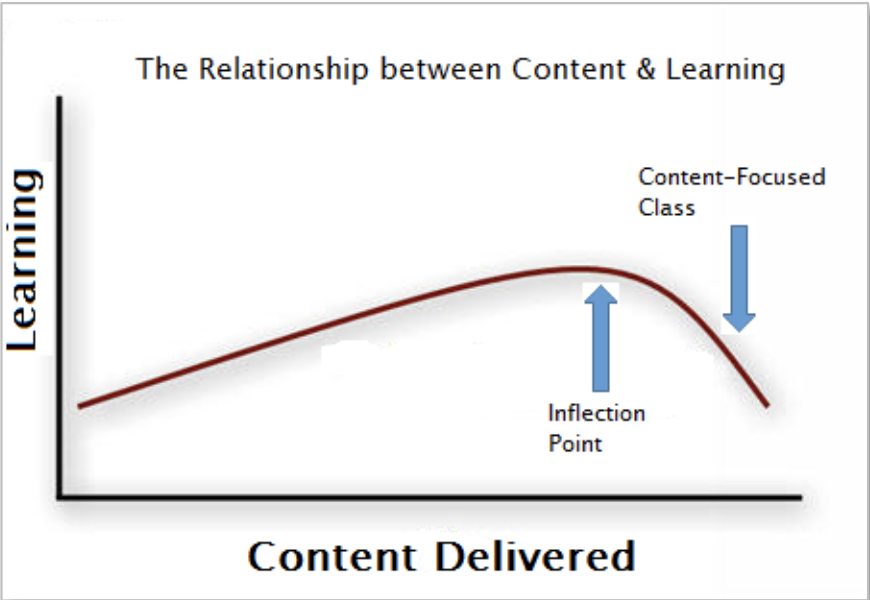Problem-based learning (PBL)—as well as other inquiry-based pedagogies—enhances student learning by engaging students in the learning process. Students engaging in PBL solve problems, think analytically, and work with ambiguous information. Research consistently demonstrates the effectiveness of PBL (as well as the ineffectiveness of more passive approaches, such as lecture).
Even with the considerable evidence supporting the efficacy of PBL to enhance learning, many faculty
continue to lecture. One source of faculty resistance to PBL concerns coverage: “If I adopt PBL, will I still
be able to cover the same amount of material?” Unfortunately, the answer to this question is not simple, and requires reviewing some assumptions that are endemic to higher education:
- Covering material is a sufficient condition for students learning the material.
- Including more content in a class will result in more student learning.

Contrary to these assumptions, the relationship between the amount of content delivered in a class and the depth of student learning is complex (see Figure). Adding content can indeed enhance learning, but only until the content reaches students’ cognitive limits for processing information. Beyond this inflection point, additional content rapidly obstructs students’ ability to engage with the material in a deeper way. Moreover, this inflection point can occur not only over the course of a semester, but also within a class. Students who passively listen to an instructor’s lecture quickly reach their cognitive limit, because students often cannot process all of the information in a lecture. Hence, the illustrated inflection point is valid not only over the course of a semester, but also within each class
Unfortunately, faculty often underestimate students’ physical cognitive limits (both within a class and across a semester), tending to integrate more content than students can deeply integrate and understand. Out of physiological necessity, well-meaning students will gravitate toward shallow learning strategies (e.g., skimming chapters, highlighting the text, developing mnemonics) in an attempt to memorize, cram, and facilitate shortterm recall. Ironically, the signs of shallow learning are often obvious. Students, for example, may fail to recall or understand concepts after a short time. Students may also complain that exams are not reflective of class examples, when the exam simply has changed the question’s context. Even though such symptoms indicate that faculty are using a teaching strategy that encourages shallow learning, the common faculty response is blaming the student.
Solving this problem requires a shift in faculty’s mindset from a focus on content (what do my students know?) to a focus on process (What can my students do?). Process objectives include communication skills, teamwork, analytical reasoning, and problem solving, among others. Such a shift also necessitates a change in faculty’s teaching strategy, because students cannot learn how to be good communicators (or teammates, or problem-solvers, or analytical thinkers) from a lecture. Moreover, achieving mastery requires allocating considerable class time to practice and to learn from mistakes. Students need to make mistakes to develop the cognitive capacity to become effective thinkers and decision-makers.
If developing process skills requires considerable class time, how can faculty achieve their content objectives? To mitigate content concerns, one approach that is gaining popularity is the use of flipped classroom models. A flipped model leverages the best of both the internal and external classroom. Faculty can take advantage of the external classroom by requiring students to read chapters or watch videos outside of class. An in-class quiz can then confirm that students are prepared. Faculty can also easily make their lectures available outside of class by recording their lectures. Unlike a live lecture, posting videos enables the student to overcome their cognitive limits by viewing videos as many times as necessary to understand the foundational concepts.
Shifting lectures to the external classroom has an added benefit: it can free up considerable time for students to practice in the internal classroom—that is, when faculty meet with students during the schedule class time. To achieve deeper learning, the internal classroom can then become a place for students to practice, to fail, to improve, and to develop their abilities. Feedback from faculty is critical: faculty can enhance learning by embracing student failure, by encouraging students to make mistakes, and by providing constructive feedback during class. Deeper learning can only occur through iteration, through formative (as opposed to summative) assessment, and through a supportive learning environment.
Faculty and students are not the only ones who would benefit from this shift in mindset: institutions of higher education have a stake in improving student learning. Students and parents are increasingly reconsidering the value of higher education as tuition costs rise. Competition from Internet-based educational offerings has increased, as online offerings become more engaging. Production values on sites such as Udemy, Khan Academy, and Coursera have improved, as have the integration of gamification, context-specific feedback, and reward mechanisms. Free sites such as Khan Academy are providing a multifaceted learning environment that is more effective than many college classes. Hence, the value of a contentladen lecture is quickly becoming less valuable and more expendable, since an Internet search can provide almost any fact in a matter of seconds. But leveraging these improved resources also provide an opportunity for faculty to release their control on content delivery.
Viewing the adoption of PBL and other active learning pedagogies as reducing the opportunities for content coverage is shortsighted, because a continued focus on content delivery is an educational dead-end. Instead of viewing the integration of student engagement as reducing content, faculty should instead view it as an opportunity to free up time that will allow students to practice, iterate, improve, and eventually achieve deeper learning. Pedagogies such as problem-based learning, project-based learning, and team-based learning all offer promise to improve and deepen student learning, but these promises can only be realized if faculty release control and free up class time to allow students to actively engage in the material.

